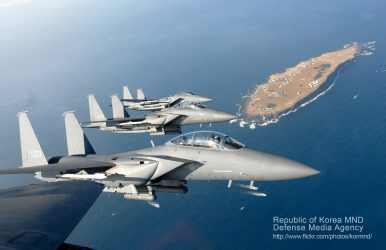By Robert Farley
 A recent Jane’s Defence Weekly profile by Jon Grevatt investigated the ROK’s defense industry in depth. From a low base in the late 1960s, South Korea has progressively developed a sophisticated, productive arms industry to serve its own forces and, increasingly, the export market. South Korean exports have steadily increased since the early 2000s, and now cover a range of high-technology weapons systems delivered to customers around the world. But there are risks on the horizon.
A recent Jane’s Defence Weekly profile by Jon Grevatt investigated the ROK’s defense industry in depth. From a low base in the late 1960s, South Korea has progressively developed a sophisticated, productive arms industry to serve its own forces and, increasingly, the export market. South Korean exports have steadily increased since the early 2000s, and now cover a range of high-technology weapons systems delivered to customers around the world. But there are risks on the horizon.
Unlike many countries, the South Korea defense industry lies largely in private hands, with much of the market commanded by “chaebols” and chaebol-affiliated firms. South Korea still experiences a substantial degree of corruption in dealings between the defense giants and the government, although it’s unclear whether this degree of corruption is a serious impediment on the export market. Like many other countries, the defense sector has seen consolidation over recent years as large producers have integrated vertically and horizontally.
South Korea has several substantial advantages as it attempts to carve out a space in the arms export market. It has a high-tech domestic economy; it has a relatively high level of military spending, guaranteeing (maybe) a baseline of sales for the industry; it has access to considerable experience in international export markets (although less in those dedicated to arms); and it has one of the world’s most robust shipbuilding industries.
But it also has some disadvantages. As is the case in other mid-tier arms producers, South Korea’s military actively prefers U.S. systems to those produced indigenously. Cutting edge is cutting edge, while merely being near the cutting edge means little on the battlefield. South Korea also suffers from its proximity to U.S. export controls; because of offsets and joint projects with U.S. firms, the United States wields an effective veto over many (but not all) South Korean arms deals. South Korean officials have granted that the U.S. refusal to export certain key technologies has both slowed the KFX program and spurred domestic innovation. Both are undoubtedly important, although at this point it’s worth wondering how much longer the world can wait to see the KFX.
And indeed aerospace is the riskiest sector for South Korea to push, although perhaps the one with the greatest upside. The KAI T-50 Golden Eagle has enjoyed considerable success on the international market. But as The Diplomat has discussed in the past at some length, much will depend upon the success of the KFX fighter project. This fighter, which was hamstrung by U.S. export controls two years ago, remains in development, with projected fruition some time during the next decade. If it flies, the KFX will apparently begin as a generation 4.5 fighter, with later improvements possibly bringing it to generation 5 standards. However, many obstacles remain between the KFX and export success; these include an uncertain future market for 4.5 fighters, U.S. export controls, and ongoing technological shortcomings on the part of South Korean industry.
Professor Jong-Ha Kim, interviewed by Grevatt, suggested that South Korea cannot compete across the full panoply of the defense market, and instead should focus carefully on a few sectors where it can establish an advantage. There is much truth in this, although it is also true that the future of the market can be difficult to predict. Moreover, the entire international arms market is susceptible to changes in U.S. policy, and that while the Trump administration has not yet pushed in major shifts on this front, it has hinted both that it may relax some export control related to human rights, and that it will take a more mercantilist position on the arms trade. If that happens, both emerging exporters and established producers may find the sands shifting beneath them.
The views expressed are those of the author and do not necessarily reflect the official policy or position of the Department of the Army, Department of Defense, or the U.S. Government.
No comments:
Post a Comment